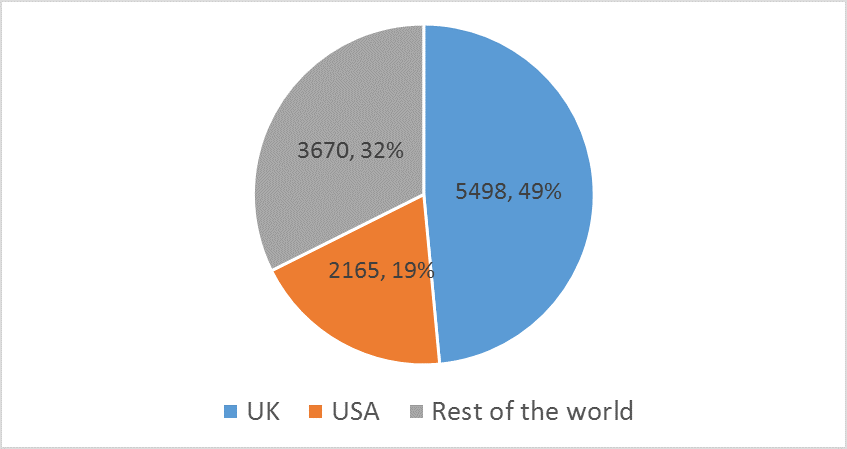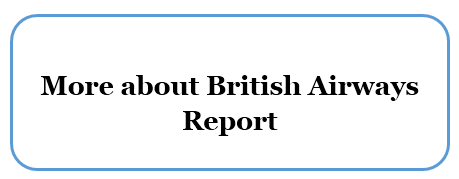British Airways SWOT Analysis
British Airways SWOT analysis is a strategic analytical tool that facilitates the analysis of strengths, weaknesses, opportunities and threats related to the business. The following table illustrates British Airways SWOT analysis:
| Strengths
1. Economies of scale due to its large size 2. Strong brand image 3. Market leadership in the UK 4. High level of service digitalization and effective integration of IT and internet |
Weaknesses
1. Overdependence on the UK market 2. Low return on invested capital (ROIC) 3. Constrained capacity of Heathrow airport 4. Lack of experience of the new CEO Alex Cruz in leading the premium segment airline |
| Opportunities
1. Formation of strategic cooperation with other businesses in airline and catering industries 2. International market expansion 3. Benefiting from synergy via Closer integration between IAG’s operating airlines 4. Improving relations with unions |
Threats
1. Further intensification of competition 2. Terrorist attacks 3. Service distuptions due to employee strikes 4. Escalation of the conflict with the UK government |
Strengths
1. British Airways flies to more than 400 destinations worldwide and its parent company International Airline Group (IAG) also owns Iberia, Vueling and Aer Lingus airlines. Thanks to the extensive scope of its operations, the business benefits from the economies of scale to a great extent. This benefit is used to further strengthen the airlines’s competitive advantage via investments in new advanced fleets and achieving a greater personalization of service provision.
2. The airline enjoys a strong brand image. In 2016 British Airways won both the Business and Consumer Superbrands awards for the second year running – the first company ever to do so. In 2015, British Airways was named by The Sunday Times and National Geographic named as best short-haul and long-haul airline. Moreover, Independent awarded British Airways the title of best European airline, while Business Traveller magazine named the airline the best short-haul carrier with the best frequent flyer programme and best airport lounges.[1] These and other awards are convincing indicators of a strong brand image that benefits the business in multiple levels.
3. British Airways operates up to 58 return services a day between Scotland and Heathrow, London City and Gatwick airports, more than any other airline. Moreover, British Airways is the only airline carrier that offers flights to New York from all three of London’s main airports; Gatwick, Heathrow and London City. The current leadership position in the UK market is a major strength for the business taking into account the size and significance of the UK airline industry.
4. Integration of IT and internet into various processes and a high level of digitalization represent solid bases of British Airways competitive advantage. These include the use of digital boarding pass by more than 28,000 customers every day[2], the launch of app for Apple Watch for faster checking at airports, the introduction of the industry’s first flat bed in the plane[3] and others.
Weaknesses
1. Over-dependence on the UK market is a considerable weakness that has to be addressed by British Airways management. As it is illustrated in figure below, almost half of all airline’s revenues were generated in the UK and about 81 per cent of revenues were generated in the UK and the US. The current situation makes the company highly vulnerable to market slowdown and intensifying competition in the UK.
British Airways revenues by geographical segment (in GBP millions)[4]
2. British Airways profit margin amounted to 10.9 per cent in 2015[5] which is less that the average airline industry profit margin of 12.72 per cent[6]. Taking into account the highly cyclical nature of demand in the airline industry, it can be argued that low profit margin leaves British Airways exposed to downsizing in the industry.
British Airways Report contains the full discussion of British Airways SWOT analysis. The report also illustrates the application of the major analytical strategic frameworks in business studies such as PESTEL, Porter’s Five Forces, Value Chain analysis and McKinsey 7S Model on British Airways. Moreover, the report contains analysis of British Airways marketing strategy, its leadership and organizational structure and discusses the issues of corporate social responsibility.
[1] Annual Reports and Accounts (2015) British Airways
[2] Annual Reports and Accounts (2015) British Airways
[3] Synetics World (2016) Available at: http://synecticsworld.com/british-airways-traveling-in-comfort-and-style/
[4] Source: Annual Reports and Accounts (2015) British Airways
[5] Annual Reports and Accounts (2015) British Airways
[6] CSI Market (2016) Available at: http://csimarket.com/Industry/industry_Profitability_Ratios.php?ind=1102


